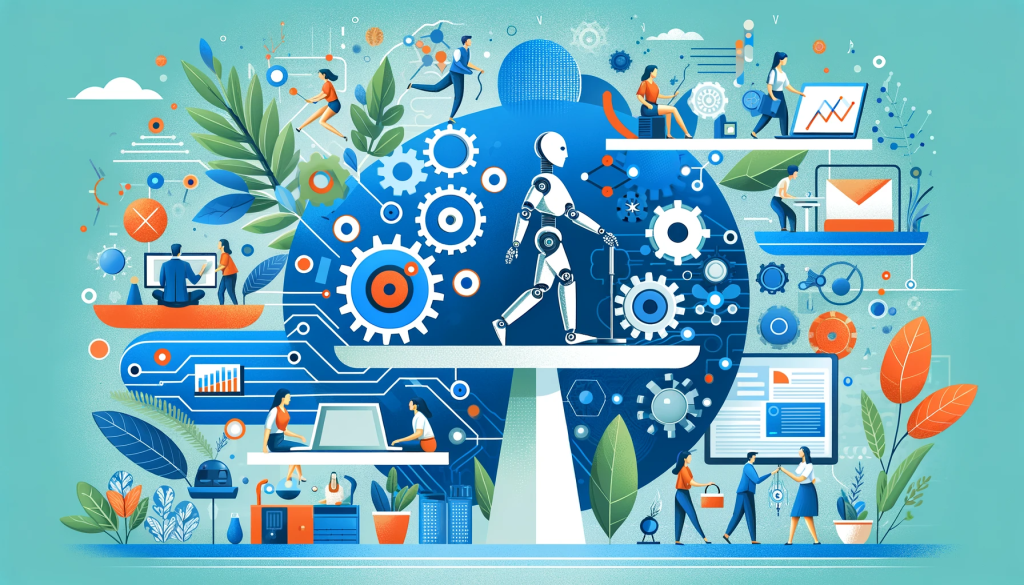At the core of the Business landscape is the human touch – an element known for its unique personal and creative contributions. However, an intriguing challenge arises in many forward-thinking companies: despite advanced technology at their fingertips, manual processes persist.
This isn’t a question of undermining human involvement; it’s about striking the right balance. Technology should not overshadow human effort; it should complement it. This article delves into this balance, pinpointing where manual work, valuable for its human element, may unintentionally lead to time and cost inefficiencies. We invite you to join us in exploring this complex interplay, seeking ways to harmonize the indispensable human touch with the practical benefits of automation for more efficient and effective business operations.

The Opportunities Manual Labor is Hiding
Manual processes may seem simple on the surface, but they often harbor hidden costs that can significantly impact a business’s bottom line. Consider the cumulative time employees spend performing repetitive manual tasks that could be potentially automated. The more time invested in low-value grunt work, the less time is allocated to critical thinking, creativity, and innovation.
According to a McKinsey report, about 60 percent of occupations/processes could have 30 percent or more of their constituent activities automated. This indicates a significant proportion of time spent across many jobs is devoted to tasks that could potentially be handled through automation.
Beyond the opportunity cost of forfeited productivity, manual processes also incur direct financial costs. There are wages paid for time spent on mundane tasks that could be spent on more critical and customer-facing tasks instead, costs associated with errors and rework, expenses related to onboarding/training new employees, and more. These costs can really add up.
The bottom line is that time equals money. Manual processes inevitably consume more time due to their inefficient nature. The costs of maintaining these antiquated systems exceed their benefits. Introducing automation allows businesses to reduce the hidden costs of manual labor and realize substantial time and money savings. The key is striking the right balance between leveraging technology while still preserving the human touch.
In-Depth Analysis of the Pain-Points in Manual Processes
Behind the facade of simplicity in manual processes lie deep-seated issues that silently erode business performance. Consider the daily grind of an employee mired in manual data entry – it’s more than just a routine; it’s a significant barrier to personal and company growth. The major pain points include:
Time Drain
Consider employees’ countless hours on repetitive tasks like data entry. These are hours lost when their talents could contribute to innovative and strategic projects instead. This isn’t just inefficient; it’s a disservice to their potential.
Error Prone
Every manual process is vulnerable to human error. These aren’t just simple mistakes; they can cascade into costly reworks and corrections, impacting financial health and client trust.
Scalability Issues
Imagine a business trying to expand but held back by the limitations of manual methods. It’s like trying to run a marathon with weights tied to your feet – possible but unnecessarily challenging.
Finding the Automation Sweet Spot
Automation is not about replacing the human touch; it’s about empowering it. The goal is to identify where automation can uplift and complement manual efforts, creating a harmonious workplace. This includes:
- Automating Routine Tasks: By automating mundane tasks, we free our colleagues to engage in work that truly matters, work that demands their unique human judgment and creativity. It’s about giving them the space to shine.
- Data Accuracy and Analysis: Automated systems manage and analyze large volumes of data with a precision that human effort can’t match. This isn’t just about numbers; it’s about gaining clear, accurate insights that drive smarter, more informed decisions.
- Scalable Operations: Automation paves the way for businesses to grow without being bogged down by the limitations of manual processes. It’s about building a foundation that supports expansion and innovation, ensuring a future-proof business.
Pinpointing Industry-Specific Automation Hotspots
Hospitality: Automation in hospitality is revolutionizing guest experiences and operational efficiency. From automated back-office processes to AI-driven customer service, technology streamlines operations, elevating the guest experience while allowing staff to focus on personalized service.
Manufacturing: In the manufacturing sector, automation is key to enhancing production efficiency. From assembly lines to inventory management, automated processes ensure precision, reduce downtime and improve safety, leading to increased productivity and cost savings.
Real Estate: Automation in real estate transforms everything from property management to client interactions. Automated systems facilitate efficient property listings, client communication, and market analysis, providing a competitive edge in a fast-paced market.
Automobile Industry: The automobile sector leverages automation for designing, testing, and manufacturing processes. Automation accelerates production cycles, improves quality control, and enhances innovation in vehicle development as well as in getting the right buyers to buy any automobile.
Shared Services: Shared services across industries benefit from automation by optimizing back-office operations such as data entry, payroll processing, and document management, leading to increased operational efficiency and reduced costs.
Banking and Mortgage: In banking and mortgage, automation streamlines complex financial processes like loan origination, risk assessment, cheque processing and compliance reporting, enhancing accuracy and customer service efficiency.
Highlighting Key Processes Across Industries: In all these industries, automation significantly impacts financial operations, customer service, employee management, and support functions. By automating routine and complex tasks alike, businesses across sectors are achieving unprecedented efficiency and strategic agility, allowing teams to focus on innovation and value-added activities.
For Business leaders, the benefits of implementing Automation are twofold: enhanced agility in business operations and a boost in innovation as employees dedicate more energy to growth and improvement projects. Implementing targeted Automation is, therefore, not just an efficiency measure but a critical strategy for competitive and sustainable business growth.
Embracing Automation: A Win-Win Strategy
Embracing automation in business is a delicate yet rewarding endeavor, offering a win-win strategy by harmonizing technology with the invaluable human element.
For example, the following case study of a Major Mutual Fund RTA in India illustrates the profound impact of automation in addressing specific challenges, significantly reducing costs, and improving operational efficiency. It showcases the power of automation to transform business processes, even in complex and highly regulated industries like asset management.
- Challenge: The manual process for changing bank account details, involving physical forms and cheques, was slow and error prone.
- Impact: Investors faced a 2-3 day wait time for processing changes, and the manual system limited check processing capacity.
- Solution: The company implemented an automated solution for processing bank account changes.
- Result: Achieved a remarkable 75% cost reduction within just two months, streamlining the process and enhancing both efficiency and customer satisfaction
This case study not only highlights the tangible benefits of automation in terms of cost reduction and efficiency gains but also underscores the broader theme of our discussion: finding the right balance between human capabilities and technological advancements. By automating the labor-intensive process of bank account changes, the company was able to shift its focus from mundane, error-prone tasks to areas where human insight and interaction are crucial.
Here’s how businesses can approach this integration
Assess and Identify: Evaluate current processes to identify where automation can bring the most benefit. Look for tasks that are repetitive and prone to errors.
Gradual Integration: Implement automation incrementally without disrupting your existing systems. Utilize tools that can integrate with your current infrastructure, allowing for a smooth transition.
Boost Efficiency and Accuracy: Automating routine tasks frees employees to do more strategic and fulfilling work. This not only improves productivity but also enhances data accuracy and decision-making quality.
Scalable Solutions: Choose automation tools that can grow with your business, ensuring they can handle increasing volumes of tasks and data.
Adaptability: opt for flexible automation solutions that can quickly adapt to market changes and requirements, regulatory requirements, and evolving business needs.

Preserving the Human Element: Where It Remains Irreplaceable
In our pursuit of efficiency through automation, it’s crucial to recognize areas where the human touch is not just beneficial but essential. These aspects of business thrive on personal interaction, empathy, and nuanced judgment – qualities that technology cannot replicate.
Creative and Strategic Thinking: While automation excels in handling data and routine tasks, it cannot replace human creativity and strategic insight. Fields like marketing, product development, and strategic planning require a human touch to innovate and envision the future.
Complex Decision-Making: Situations that require ethical considerations, emotional intelligence, and complex judgment call for the irreplaceable human element. These include executive decision-making, conflict resolution, and customer relationship management.
Customized Client Interactions: Personalized service, especially in industries like hospitality, healthcare, and high-end retail, relies on the human ability to understand and react to unique customer needs and preferences.
Adaptability and Crisis Management: Humans excel in adapting to unforeseen circumstances and managing crises. In dynamic environments or situations requiring rapid response, the agility and problem-solving capabilities of humans are paramount.
Empathy and Emotional Connection: Roles that require empathy, such as HR, counseling, and customer service, benefit from the genuine emotional connection that only humans can provide.

In conclusion, the journey towards embracing automation in business is not just about adopting new technologies; it’s about reshaping the way we work for the better. Automation, when thoughtfully integrated, is a powerful ally that enhances efficiency, unlocks employee potential, and sharpens a company’s competitive edge. It’s about creating a synergy between the irreplaceable human element and the unmatched efficiency of machines.
As we stand at this technological crossroads, the future is bright for businesses that recognize and harness the transformative power of automation, blending it seamlessly into their operations and culture. This is not just an evolution in business practices; it’s a step towards a more efficient, innovative, and human-centric world of work.
Want to learn more about where to start your automation journey? Get in touch with us today! We’re ready to help you discover the ideal automation strategies for your unique business needs.










